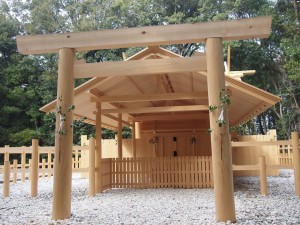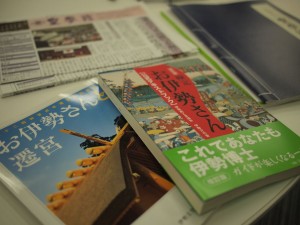Learning about Ise at Kogakkan: Day 1
Kōgakkan University is a small private college in a city in rural Japan called Ise, home of the most important Shinto shrine, Ise Jingū. This month, I join other masters’ students on a Shinto studies program at Kōgakkan. We’ll be touring all over the city and surrounding countryside, hearing lectures in Japanese from some notable scholars in the fields of Japanese history and religion. I will be sharing much of what I see and hear, so this blog will have more updates than usual.
There are thousands of Shinto shrines across Japan, but there is only one Jingū. The Jingū is where the most ancient figures of the Imperial line are worshiped. The kanji for Jingū 神宮 is “kami + miya”, where a miya implies something like an Imperial palace. If a shrine (jinja) implies a dilapidated old altar on the side of the road, a palace (miya) is a new building, regularly rebuilt to prevent decay, that can only built on Imperial grounds. Indeed, ordinary citizens are not allowed inside the central building, or honden 本殿 of the Jingū. We must stand at the outermost gate. Only the Emperor and his family are permitted to enter.
Ise Jingū consists of two different legal organizations, the Gekū (外宮 “Outer Miya”) and the Naikū (内宮 “Inner Miya”). The Naikū is also known as Kōtai Jingū, or the Emperor’s Jingū. The most important kami at the Jingū is Amaterasu-Oomikami, who is housed in the central miya of the Naikū. The Gekū houses Toyouke-Oomikami, who was called to Ise to prepare Amaterasu’s food. As is common across all ancient societies, the offering of food to the highest ancestor is a very serious matter: in this case, so serious that part of the Jingū is dedicated to the kami who would prepare that food.
Kōgakkan, located between the Naikū and the Gekū, is one of only two universities in Japan that has the promotion of Shinto as its founding mission. Shrine priests are also trained here. This means that some unusual groups are coming through; today in the Kōgakkan lunchroom, there were a bunch of young men dressed in shrine priest robes who sang a Shinto prayer before and after eating. I am sure that I will see and learn many more interesting things in the days to come.
This program has assembled a motley crew of Japan scholars from across Europe and the US. It includes a Romanian comparative literature student with an interest in Jungian archetypes, a Spanish guy who quit his job (a rare thing in Spain these days) to make a serious study of early modern cultural exchange, and two Poles from the same school who do a remarkable job of being a tsukkomi and boke. When he introduced himself to our professors, the boke insisted that they call him “Micchan”, so I’ll refer to him by that name on this blog. The people at Kōgakkan have been very nice and showered us with gifts as we started the program today. They’re also paying for all of our meals and a free guided tour of Kyoto. Below, some of the books they gave us:
After the opening ceremony today, we heard a lecture from the president of the college, a Shinto historian named Shimizu Kiyoshi 清水潔. Shimizu-sensei explained that Kōgakkan was founded in 1887 as a reaction to Tokyo University having no Eastern readings in its original curriculum. To give us a taste of the early Meiji love of all things Western, he related the episode of the Rokumeikan, where Japanese nobles built a modern dance hall and attempted to hold fancy dress parties in a perfect copy of European fashions, only to trigger harsh critique from Westerners who found the empty imitation of their social rituals uncomfortable and eerie.
Japan had a need to blaze its own trail and assert itself as a developed country, without endlessly imitating Europe. Shimizu-sensei quoted from German archaeologist Heinrich Schliemann’s 1865 account of his visit to Japan. Schliemann was apparently impressed with Japan’s mastery of Western technologies, but felt that Japan lacked “spiritual development” — that is to say, Christianity. In this context, the philology and classical studies promoted at Kōgakkan could be helpful to Japan in demonstrating its moral worth as a nation. Shimizu-sensei is of the opinion that even today, Japanese people need a firm grounding in their own language and history in order to explain their culture to foreigners.
Shimizu-sensei discussed briefly how Kōgakkan was closed in 1945. He only briefly mentioned that the primary reason for the closure is that the town of Ise was razed to the ground by American bombing. This began with, in January 1945, the destruction of several Gekū buildings, and continued into the summer with severe damage to Kōgakkan. The school did not reopen until 1962, with the support of alumni who had become wealthy in the postwar years. No longer would it be a public Shinto institute; now it was a private college, which has focused increasingly on education in recent years.
Sir Arthur Toynbee visited the Jingū in 1967. He left a message for the people of Ise where he described his experience at the Jingū as affirming the “underlying unity of all religions.” Shimizu-sensei apparently found this phrase very moving and he repeated it several times. Maybe he should read Frithjof Schuon.
We were given a tour of the campus — I was especially interested in the Jingū’s private archives, the Japanese equivalent of the Vatican Secret Library, which are located right next to the library — and enjoyed a free lunch. After lunch, a shrine otaku showed us around the nearby Yamatohime-no-miya and explained how to do sanpai (paying respects). Here he is with my classmate Jonathan:
Yamatohime-no-miya was just renewed for the 2013 shikinen sengū, a recurring 20-year event where all of the shrine buildings at the Jingū are torn down and rebuilt. As Shimizu-sensei reminded us, the shikinen sengū has been going on for over 1300 years. Our otaku guide, Sano-san, gave us some very complex and technical information about the circumstances surrounding Yamatohime-no-miya’s founding (it’s actually a new shrine) and its ranking in the internal Jingū shrine system (it’s called a betsugū).
Following this, we had two lectures on the history of Ise from Okano Tomohiko 岡野友彦, a medievalist with a specialty in reading premodern Japanese literature. By this point my hike had worn me out, but I was awake enough to understand the important point that for much of its history before the 20th century Ise was dominated by two alliances, the Yamada Triad and the Uji Assembly, which controlled the pilgrimage businesses around the Geku and Naiku, respectively. He described a 1486 event where the Yamada refused to allow visitors to pass to the Naiku, which caused the Uji in return to call upon a neighboring warlord, Kitabatake Masasato, to give the Yamada an ultimatum. When they ignored him, Kitabatake and his crew set fire to the entire Gekū pilgrimage area and murdered the Yamadas indiscriminately. Some of the Yamadas were murdered inside the Gekū, which caused it to fall into a state of impurity. Okano-sensei did not mention this, but the Yamada and Uji actually called the Kitabatake warlords to intervene in their disputes (i.e. help kill each other) about ten times from 1400 to 1600, something which should have pleased the Kitabatakes very much, as it allowed them to build their power base in the Jingū area. It is not surprising in this context that the only time in history that the shikinen sengū was interrupted was the period from 1460 to 1580. The shrinekeepers must have been remarkably impoverished at this time.
After the Meiji Restoration, Ise Jingū took on renewed importance, and by 1930, with the expansion of the imperial cult, there were plans to turn it into a sacred city, similar to how the Saudis have attempted to renew Mecca. In 1940, the 2600th anniversary of Japan’s founding, a plan was approved to completely remodel the area. But in a typically shortsighted way for the time, the people who signed off on this plan did not realize that Japan’s increasing disregard for Western interests had set it on a path to total war. Okano-sensei described the postwar atmosphere at Ise, in an era when the Jingū had been bombed and damaged and the Kōgakkan abandoned, as a “hard blow spiritually” 精神的痛手. But the Jingū was rebuilt with private funds and continues to conduct the shikinen sengū today, with increasing interest from the Japanese public. Over the course of 2013, 13 million pilgrims came to see it happen.
Another thing we learned from Okano-sensei is that it always rains on or near the day of the Naiku sengū. After class we had a welcome party where I tried and failed to strike up a conversation with my professors, and then we students enjoyed a nijikai (second party) with all the extra beer and liquor left behind from the party. Okay, that’s it for today!
Posted: February 23rd, 2015 | Kogakkan



